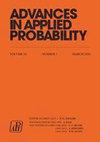定向优先依恋网络中互惠性的测量
IF 1.2
4区 数学
Q3 STATISTICS & PROBABILITY
引用次数: 7
摘要
摘要实证研究(如Jiang et al.(2015)和Mislove et al.(2007))表明,在线社交网络不仅具有Pareto样尾部的内外度分布,而且具有较高比例的倒易边缘。一个经典的有向优先附着(PA)模型产生具有幂律尾的进出度分布,但该模型中互易特征的理论性质尚未得到研究。我们导出了两个固定节点之间倒易边的数量以及倒易边在整个PA网络中的比例的渐近结果。我们看到,在某些参数的选择下,有向PA网络中倒易边的比例接近0,这与经验观察不同。这指出了将经典PA模型拟合到具有高互易性的给定网络数据集的一个潜在问题,并表明需要考虑替代模型。本文章由计算机程序翻译,如有差异,请以英文原文为准。
Measuring reciprocity in a directed preferential attachment network
Abstract Empirical studies (e.g. Jiang et al. (2015) and Mislove et al. (2007)) show that online social networks have not only in- and out-degree distributions with Pareto-like tails, but also a high proportion of reciprocal edges. A classical directed preferential attachment (PA) model generates in- and out-degree distributions with power-law tails, but the theoretical properties of the reciprocity feature in this model have not yet been studied. We derive asymptotic results on the number of reciprocal edges between two fixed nodes, as well as the proportion of reciprocal edges in the entire PA network. We see that with certain choices of parameters, the proportion of reciprocal edges in a directed PA network is close to 0, which differs from the empirical observation. This points out one potential problem of fitting a classical PA model to a given network dataset with high reciprocity, and indicates that alternative models need to be considered.
求助全文
通过发布文献求助,成功后即可免费获取论文全文。
去求助
来源期刊

Advances in Applied Probability
数学-统计学与概率论
CiteScore
2.00
自引率
0.00%
发文量
64
审稿时长
6-12 weeks
期刊介绍:
The Advances in Applied Probability has been published by the Applied Probability Trust for over four decades, and is a companion publication to the Journal of Applied Probability. It contains mathematical and scientific papers of interest to applied probabilists, with emphasis on applications in a broad spectrum of disciplines, including the biosciences, operations research, telecommunications, computer science, engineering, epidemiology, financial mathematics, the physical and social sciences, and any field where stochastic modeling is used.
A submission to Applied Probability represents a submission that may, at the Editor-in-Chief’s discretion, appear in either the Journal of Applied Probability or the Advances in Applied Probability. Typically, shorter papers appear in the Journal, with longer contributions appearing in the Advances.
 求助内容:
求助内容: 应助结果提醒方式:
应助结果提醒方式:


